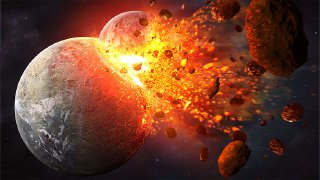A recent study has revealed the existence of a “buried planet” deep underground, believed to have played a pivotal role in the formation of Earth’s moon.
The study, which analyzed samples of mineral ores from the depths of the moon, suggests that this “buried planet” — dubbed “Thea” — was the size of Mars and collided with Earth about 4.5 billion years ago.
This catastrophic collision resulted in Thea crashing into fragments of hot lava, which later merged to form Earth’s moon.
Thea’s traces were not limited to the moon, but some theories suggest the existence of the remains of this planet buried deep in the earth, in the form of dense and huge “dots” under the African and Pacific tectonic plate.
“Regions with low pressure variations” (LLVPs) – unusually dense regions at the base of Earth’s mantle – provide further support for this theory, and studies have shown that these regions are similar in composition to the remnants of Thea found in the Moon.
Experts at Harvard, Bristol and California universities say that the moon appeared 4.5 billion years ago, when the Earth and the moon were one mass, and after a huge collision with an asteroid, the mass separated and formed the moon.
